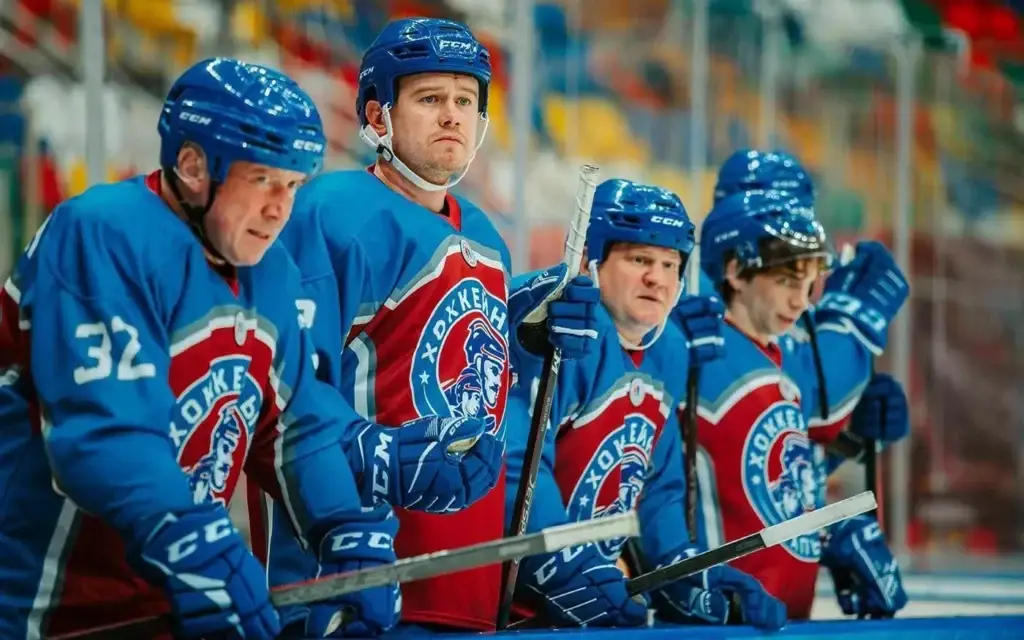Hockey is a symbol of resilience, speed and team spirit. Cinema films transform the sport into art, where drama, emotion and passion create incredible stories. Films about ice hockey reflect both triumphs and defeats, making you believe in the strength of the team and the will to win.
‘Legend Number 17’ – a story based on true events
In 2013, director Nikolai Lebedev presented the world with one of the most emotional and dramatic Soviet films about ice hockey. The plot is based on the true story of the legendary ice hockey player Valery Kharlamov, who became a symbol of the USSR’s ice hockey greatness. Screenwriters Alexei Kazakov and Nikolai Kulikov tried to trace the athlete’s path from his first steps on the ice to his outstanding career as accurately as possible. The events take place against the backdrop of a tense confrontation between the USSR and Canada.

Great struggle and drama
The picture shows an incredible fight and the desire to win. The biggest fight with the Canadian pros on the ice of Montreal was the climax not only for the plot, but also for the career of Kharlamov himself. His tenacity and will to win is reflected in every scene where the viewer can literally feel the ice under his feet and the onslaught of the Canadian players.
The Mighty Ducks’ is a comedic look at the game.
The Mighty Ducks’ is a classic of American family cinema, made in 1992 by director Steven Herek. The foreign film tells the story of former ice hockey player and current lawyer Gordon Bombay, who finds himself forced to coach a children’s team despite not liking the sport. The film combines the competitive spirit with the carefree nature of childhood and shows how hockey can bring very different people together. The script takes a unique look at the sport in the United States and focuses on important life lessons.
How a coach inspires a team
The role of coach Gordon Bombay, played by Emilio Esteves, was pivotal. He inspires the boys and helps them to believe in themselves, even when everything is against them. Bombay’s training methods are not only disciplined but also humorous, which helps him gain the children’s trust. The coach not only teaches hockey moves, but becomes a mentor to each young athlete. This approach makes the film a real comedy that will touch the hearts of viewers of all ages.
The training scenes, in which the children repeatedly get into funny situations, make the film light and attractive. The humour makes hockey accessible to all and makes the ice rink a place of fun and support.
‘Secrets of Professional Hockey’ – the rise and fall of an ice hockey legend
 Shot in Canada, this ice hockey film shows the lives of professional ice hockey players from the closest possible point of view. The story shows how the players reach the top and what they have to sacrifice for their careers. Canada, a country with a deep-rooted hockey tradition, was the perfect setting for this film.
Shot in Canada, this ice hockey film shows the lives of professional ice hockey players from the closest possible point of view. The story shows how the players reach the top and what they have to sacrifice for their careers. Canada, a country with a deep-rooted hockey tradition, was the perfect setting for this film.
How players change the world of sport
The film shows that the life of a professional ice hockey player is not just about fame, but also about constant challenges. Many of them inspire the younger generation with their achievements and resilience. Their influence on sport and society cannot be overestimated. The film was a milestone in the portrayal of hockey in world cinema. The storyline revealed the true essence of the sport: the incredible struggle, the tears and the joy of victory.
‘Red Machine’ – the spirit and strength of the USSR
The film tells about the legendary hockey team of the USSR, which not only once amazed the world with its achievements. At the centre of the plot is the historic confrontation with the Canadian national team in a series of Summit Series games in 1972, events that epitomised the Cold War on the ice.
Strategy and team
The teamwork and tactics of the USSR national team were unique. Their training was based on strategy and detailed game plans that made them unstoppable on the ice. This team proved their superiority time and time again against all odds and showed that success is the result of total hard work and discipline. In every moment of the film, the audience feels the genuine passion.
The personalities of the great players
The film also shows the personalities of great players, such as Vladislav Tretiak and Valery Kharlamov. The biographies of these athletes are inspiring and show that legends are not born – they become them thanks to years of hard work and the pursuit of excellence.
‘Mr Hockey: The Gordie Howe Story’ is about a sports legend
The film tells the story of one of the most important figures in the history of ice hockey – Gordie Howe. This Canadian athlete became a symbol of resilience and skill, his career spanned an incredible 32 years, including seasons in the NHL and WHA. Hockey on film through the prism of an athlete’s life shows not only the glorious moments, but also the hard work behind every victory.
Strength of character and athletic perseverance
Howe’s story is one of incredible strength of character. At the age of 45, he returned to the ice to play alongside his sons on the Houston Aeros team. Such perseverance is inspiring and shows that age is just a number and true spirit knows no bounds.
‘Miracle on Ice’ – the story of an incredible victory for the United States
The film describes the legendary victory of the US team at the 1980 Winter Olympics, a victory that went down in history as a true miracle. A young American team, made up of students and amateurs, was able to beat the mighty Soviet team and show that belief in success and teamwork can achieve incredible things. This film is rightly regarded as one of the best ice hockey films ever made. Herb Brooks, the coach of the US national team, played a key role in this victory. His methods were strict but effective, and it was thanks to his leadership that the team was able to achieve the impossible.
Conclusion
 Exciting games, dramatic moments, colourful personalities – all this makes ice hockey films unforgettable. Above all, however, they teach us valuable life lessons. Perseverance, determination, teamwork – qualities that are useful in every area of life. When we watch these films, we learn to overcome difficulties, believe in ourselves and achieve our goals.
Exciting games, dramatic moments, colourful personalities – all this makes ice hockey films unforgettable. Above all, however, they teach us valuable life lessons. Perseverance, determination, teamwork – qualities that are useful in every area of life. When we watch these films, we learn to overcome difficulties, believe in ourselves and achieve our goals.

 en
en  ru
ru  de
de  ar
ar  es
es  hi
hi  fr
fr  nl
nl  it
it  pt
pt  el
el 



